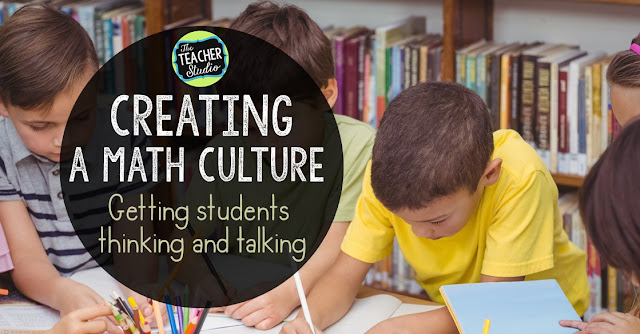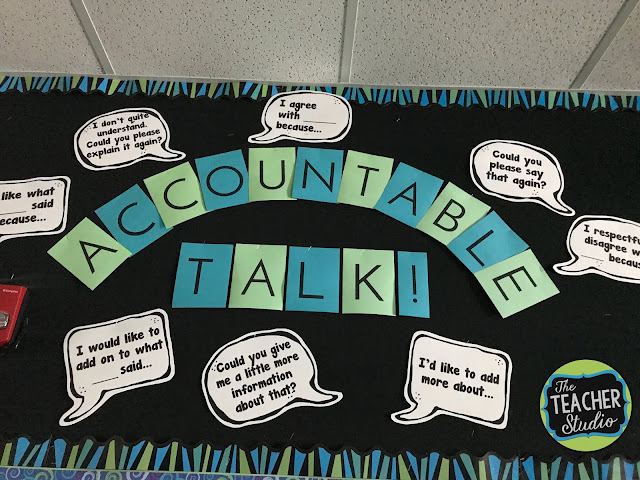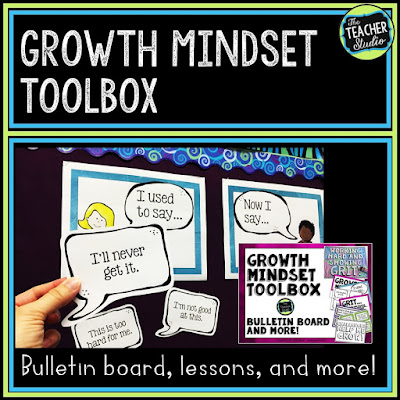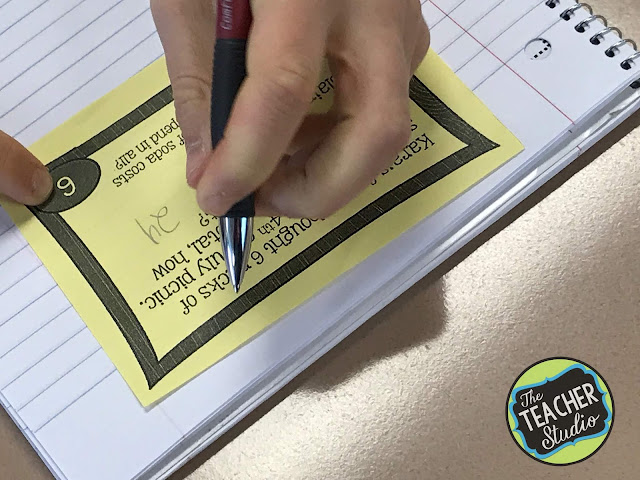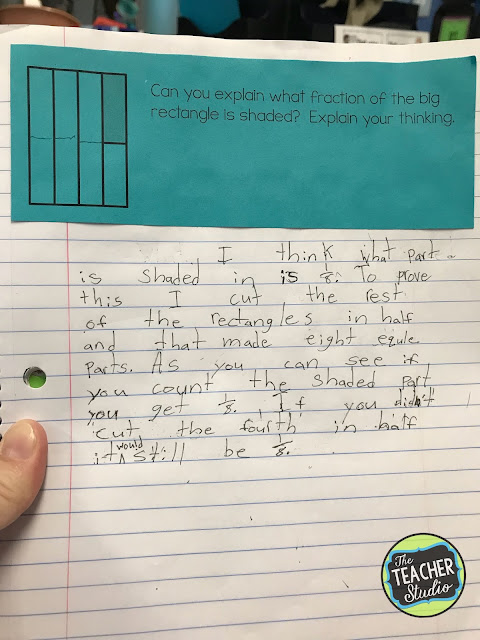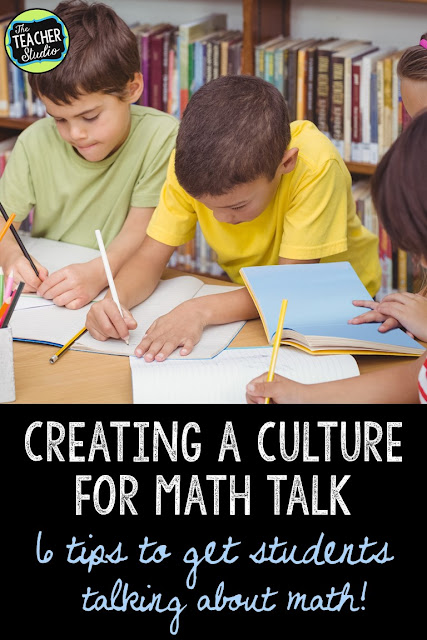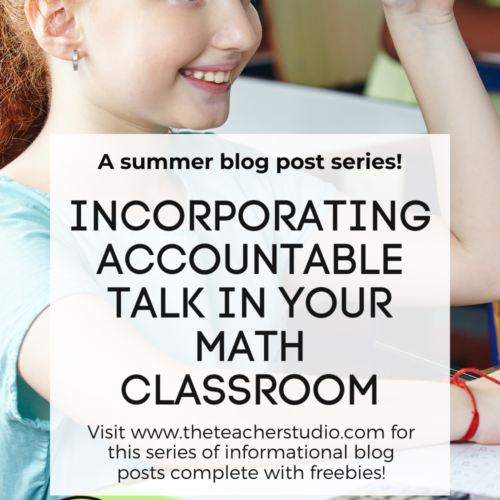







So now that many of us have sketched out our year and have done some thinking about the sequence of instruction, resources we have at our disposal, and so on–it’s time to start considering the math culture and math talk we want our classroom to have. This is a little less tangible than writing things down on a calendar, so I have a little food for thought as you ponder this idea.
1. Accountable Math Talk
We know that we want students talking about their work through academic discourse, and we have talked for years about increasing students’ depth of understanding. I think–especially at the elementary level–that we need to take the time to give students the tools to do this. It requires the language piece, a growth mindset (below), modeling (below), and a culture where this is supported.
I have a few tips on how to get started if this is new for you!
1. Post sentence stems somewhere that students can easily access and you can point to for support. This is the display in my room…I just printed big letters (two per page) to spell “accountable talk” and then made the speech bubbles. You can grab them for free HERE if you want. I have another set of posters for free in my store by clicking HERE. Hopefully one will work for you if you need something like this!
2. Focus on partner talk and then move to bigger groups. I love using my “talk starters” to help students learn to listen, ask follow up questions, piggy back off ideas, and so on. You can easily make these on index cards, but I like to have a big set at my fingertips, so I created THIS SET so I can work discussion practice into my daily routine–not just in math class.
3. Point out examples of good collaborative talk or areas for growth. By noticing things like “Malinda did a nice job of piggybacking off your comment. Does anyone else want to add on?” or “Remember, if you don’t understand her explanation, you can say things like ‘Could you please repeat that?’ or ‘I didn’t understand the part about…'”. Sometimes bringing these examples to students’ attention helps make it all more clear. Also, this really contributes to the climate in your classroom.
2. A focus on growth mindset
Jo Boaler has some great video clips on Youcubed.org, and if you haven’t signed up for this, you are missing an amazing resource! Her book “Mathematical Mindsets” should be required reading, in my opinion (I’ll put my affiliate link at the bottom of the post if you are interested…a great book at a really reasonable price).
3. Math Talk: Modeling, modeling, modeling
Anyone else?
- Show how to DO math is less important than showing how you approach math and the decision making you go through when doing math.
- Showing how math concepts are related to each other is as important as modeling each concept alone
- Remembering that the TEACHER is not the only one who should be modeling is critical
- Students model with each other when doing collaborative tasks. As teachers, we need to circulate and listen for great math thinking…coach where needed to get it to that level…and then have them share out with others.
- Using a document camera or a whole-class meeting is a great way for students to share discoveries, strategies, and more
- A “fishbowl” is a great way to showcase great modeling–of thinking and math work
- Remember, modeling doesn’t have to be for the entire class. A student can model their thinking for one other student who is struggling–or one small group can pair up with another to showcase great math.
- And more!
4. Number talks and math warm ups
Math Warm Up Ideas
- Number talks
- A writing prompt…give students a few minutes to write, then a few minutes to share, then a few more minutes to write after hearing the ideas of others. (For example, “What do you know about equivalent fractions?” or “What are some patterns in multiplication?” or “How can you explain the difference between prime and composite numbers?”). I love that it gives students time to think–and then time to listen and process–and then time to add on to their own thinking. This is an example from my big fraction unit…it led to GREAT writing and discussion!
- Partner problem solving…and I’ll get more into this in my next challenge!
- A debate…for example, “It is impossible to draw a triangle with two right angles.” Or “Any time you divide a number by 4, the answer will be even.” Again, I would encourage you to give some individual “think time” before the discussion or you will find the same students participating. Just slowing down to get more students on the playing field makes a huge difference.
- Studying, continuing, and discussing patterns, sometimes I do throughout the school year. I have a few different things I do, but I did put together a set of pattern task cards that has been a life-saver for me! They get stored right by my document camera and about once each week I use one as a discussion starter. I also have some pattern work in my”More Than a Math Center” resource. There are all sorts of things online that you can find, but I know I do better with things when I don’t have to go searching, so I get all my supplies organized and in one place for easy access.

- Daily math open ended warm ups. I use these all the time to get math talk flowing! Sometimes I project them. Sometimes I send them digitally. Other times I print them. I have samples for grades 3 and 4 for free if you are interested. The bundled sets for the entire year are also available. Here is a blog post with more information.
- Finally, one of my favorites is below–and I felt it deserved its own heading!
5. My favorite mistake
- Sometimes I find mistakes on a formative assessment (or even summative!) that I think would make a worthy discussion. (more on this in an upcoming challenge!)
- Other times I hear students SAY something that shows a misconception.
- Sometimes I find careless errors in daily work or other activities
- And at other times I find examples of precision and accuracy errors. One example would be failing to line up the decimal point when adding decimals.
6. A culture to collaborate–not to compete
Get this math talk freebie delivered right to you…just CLICK HERE!
Click HERE for Challenge 2 (math talk and mindset)
Or HERE for Challenge 3 (word problems and problem solving)
Click HERE for Challenge 4 (math organization)
Or HERE for Challenge 5 (math assessment)
Click HERE for Challenge 6 (meaningful problem solving)

